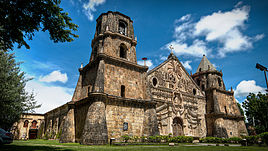
Back بيسايا الغربية Arabic Rehiyon Sulnopan na Kabisayaan BCL Visayas Occidentals Catalan Visayas Occidental CBK-ZAM Kasadpang Kabisay-an CEB Western Visayas German Okcidentaj Bisajoj Esperanto Bisayas Occidentales Spanish Mendebaldeko Bisayak Basque ویسایای غربی Persian
Western Visayas
Kabisay-an Nakatundan Kanlurang Visayas | |
|---|---|
 Location in the Philippines | |
| Coordinates: 11°08′N 122°32′E / 11.13°N 122.53°E | |
| Country | |
| Island group | Visayas |
| Regional center and largest city | Iloilo City |
| Area | |
• Total | 12,750.63 km2 (4,923.05 sq mi) |
| Highest elevation | 2,117 m (6,946 ft) |
| Population (2020 census)[1] | |
• Total | 4,730,771 |
| • Density | 370/km2 (960/sq mi) |
| Time zone | UTC+8 (PST) |
| ISO 3166 code | PH-06 |
| Provinces | |
| Independent cities | |
| Component cities | |
| Municipalities | 98 |
| Barangays | 3,209 |
| Cong. districts | 10 |
| Languages | |
| GDP (2023) | ₱620.79 billion $10.55 billion[2] |
| Per capita | $2,225 (2023 est.)[2] |
| HDI | |
| HDI rank | 5th in the Philippines (2019) |
Western Visayas (Hiligaynon: Kabisay-an Nakatundan; Tagalog: Kanlurang Kabisayaan; Filipino: Kanlurang Visayas) is an administrative region in the Philippines, numerically designated as Region VI. The region comprises the islands of Panay and Guimaras. It consists of five provinces: Aklan, Antique, Capiz, and Iloilo on Panay, and the island province of Guimaras. The region also includes one highly urbanized city, Iloilo City, which is the largest city and serves as the regional center.[3]
The Hiligaynon language, native to Iloilo City, is the region's lingua franca. The region is also dominated by the native speakers of three Visayan languages: Kinaray-a, Aklanon and Capiznon. The land area of the region is 12,750.63 km2 (4,923.05 sq mi), and with a population of 4,730,771 inhabitants.
- ^ Census of Population (2020). "Region VI (Western Visayas)". Total Population by Province, City, Municipality and Barangay. Philippine Statistics Authority. Retrieved July 8, 2021.
- ^ a b "2021 to 2023 Gross Regional Domestic Product (GRDP)". openstat.psa.gov.ph. Philippine Statistics Authority. Retrieved April 26, 2024.
- ^ "History of Urban Growth of Iloilo City". Iloilo City Government. Archived from the original on June 30, 2012. Retrieved June 28, 2012.








